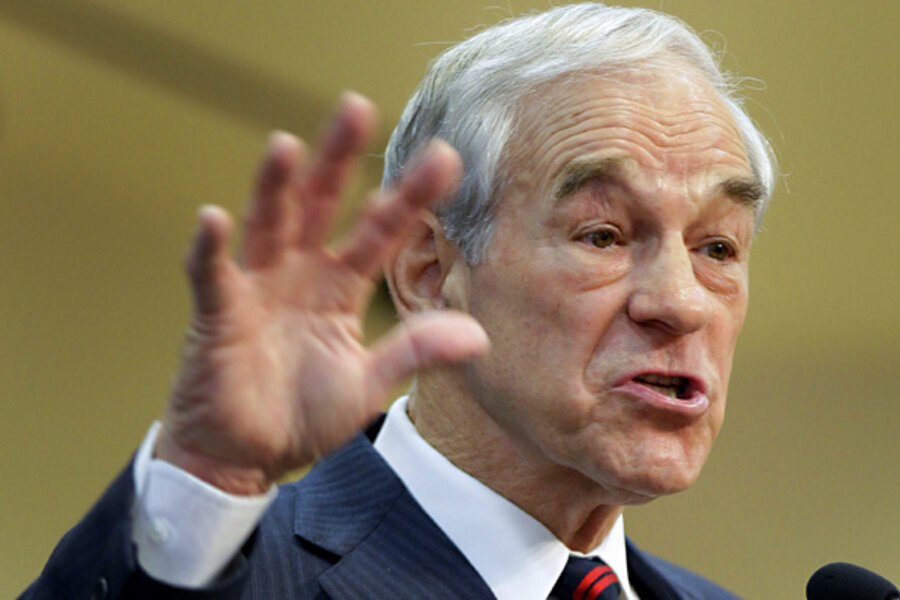Is Ron Paul's gold standard idea dangerous?
Loading...
With the campaign carnival stopping in Nevada this week for Saturday’s Republican caucus, the Las Vegas Sun’s J. Patrick Coolican takes Ron Paul to task for Paul’s call to end the Fed and return to gold. Coolican writes:
To start with, inflation is not a problem right now. The Fed has effectively controlled inflation since Paul Volcker, who was appointed by President Jimmy Carter, began to rein in inflation 30 years ago. (Most important, inflation rates have been stable and predictable, which allows for economic planning by firms and households.)
Let’s see, Tall Paul left the Fed in 1987. Using even the establishment’s numbers via “The Inflation Calculator” what cost a $1.00 in 1987 cost $1.89 in 2010. So the value of the dollar has been cut in half just since 1987 using the most conservative numbers. What’s stable and predictable about cutting the value of the dollar in half?
Coolican doesn’t understand what all the fuss is about concerning the tripling the Fed’s balance sheet (he writes that “the Fed has tripled the money supply” since 2008 which isn’t right M-2 is up 29%). He says prices have increased 1.5% per year. What’s the problem?
Even according to the government CPI increased 3% over the past 12 months. If one calculates CPI the old fashioned way as John Williams does on Shadowstats.com, price inflation is running at more than a 10% clip.
Coolican then enlists the services of UNR economist Elliott Parker, who says monetary matters were a mess before the steady hand of the Fed came to be in 1913. “It’s an absurd argument because before the Fed prices were unstable in the short term, and long term there was a long period of deflation,” says Parker.
Look at any historical long-term chart of the CPI and it’s a flat line until heading skyward starting in 1971. And what’s so bad about falling prices for a long period of time. That’s how we all become better off is when goods and services become more affordable through technological improvements.
The long depression Parker talks about (1870s to 1900) was actually a period of great prosperity. This period of the classical gold standard was marked by gently falling prices leading to increased productivity, raised living standards, and the first glimpses of globalization.
Jim Grant of Grant’s Interest Rate Observer writes, “you can look far and wide without finding a decade so ebullient, prosperous and — in so many ways —so modern as that of the 1880s.”
While prices fell, the US economy prospered. Industry expanded; the railroads expanded; physical output, net national product, and real per capita income all roared ahead. For the decade from 1869 to 1879, the real national product grew 6.8% per year and real-product-per-capita growth was described by Murray Rothbard, in his History of Money and Banking in the United States: The Colonial Era to World War II as “phenomenal” at 4.5% per year.
And no there was no Fed back then to bail out Wall Street, so malinvestment was liquidated quickly and in turn the economy recovered quickly. So while Coolican says, “The world would have collapsed without aggressive action by the Federal Reserve.” The financial world needed to collapse and hasn’t been allowed to as the Fed continues to prop it up. Thus, the pain continues.
Coolican and Parker think falling prices create less incentive to produce. But they leave out the cost side. As costs fall through innovation, profit margins remain. All inflation does is hide inefficient producers. As for the worry of wages falling, it’s not the amount of your wages, but how much will your wages buy.
But the hundreds of years of evidence supporting gold money doesn’t convince Parker. He says, “But there is no evidence that getting rid of the Fed and replacing it with private banking along the lines of a gold standard would help the economy at all. None. In fact, the idea scares the hell out of me.”
Another reminder of the quality economics training that students are receiving at our nation’s universities.







